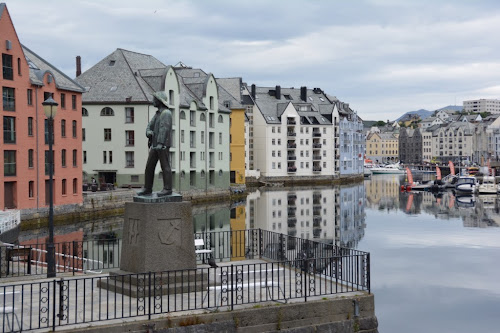Awoke at 7am in Torvik after very sound sleep following our "35 hour travel day". The Kong Harald moves so silently that we didn't realize when we awoke that we were in port. Breakfast was a generous buffet with good coffee, juice, scrambled/hard/soft boiled eggs, various Euro breakfast meats & cheeses, smoked salmon, pickled herring, an array of breads/rolls/croissants and some interesting toothpaste-like tubes--one labelled "BaconOst". The tubes were located between the orange slices and sliced cheese, so unsure if it is a condiment...and, if so, on what? Will provide further update when I gather the courage to try bacon in a tube!
 |
| Caviar, PRIM, SkinkeOst, BaconOst, and RekeOst! |
Upon arrival for a 45 minute stop in Alesund, Manfred and I hopped off the ship and headed into town. The wooden construction of Alesund burnt to the ground in 1904 and was rebuilt in an Art Nouveau style. The town is clustered on a number of islands and promontories adjacent to the open Atlantic.
 |
| Kong Harald arrives in Alesund |
 |
| Entering Alesund harbor |
 |
| Welcome to Alesund! |
We reached a small bridge in the center of town before having to make our return back to the ship. The ship's gangway is lifted 5 minutes before departure and, if late returning to the ship from town, it was advised we bring a good camera so we could take a high quality photo of the ship's departure (without us) for our scrapbook. Although we log out/in with our ship ID card, Hurtigruten also advised us "this procedure is not because we will watch/wait for your return, we simply want to know who to cross off the passenger list when we depart". Harsh!!!
 |
| Art Nouveau architectural style in Alesund |
Fjords are the trademark of Norwegian tourism. From the sea at Alesund, Geirangerfjord is reached by traversing over 100 km of fjords to finally reach a dead-end at the small village of Geiranger. The first segment of the connecting fjords contain small hill towns and villages, but then high steep mountains begin to dominate punctuated with long graceful waterfalls. Seven such waterfalls together comprise the Seven Sisters near Geiranger.
After lunch, Manfred and I joined an excursion to the UN World Heritage site, Geirangerfjord. We departed the ship via tender and were taken to the town of Geiranger where we boarded a bus. Manfred and I were on the English/French bus, where sights were narrated in both (you guessed it!) English & French. This was somewhat simpler than on the ship itself where each general announcement is repeated in Norwegian, French, German and English. Current ship passenger roster includes 176 Germans, 36 Italians, 31 Swiss, 21 Norwegians, 15 Austrians, 14 French, 7 Swedish, 3 Belgians, 8 Aussies, 3 Brits and 8 Americans. The crew of the Kong Harald is composed of 64 Norwegians.
Our excursion started up the steep Eagle Road with a series of hairpin turns climbing to the top of the mountains above Geiranger. We stopped at an overlook to watch the Kong Harald departing Geirangerfjord to return to Alesund before a rendezvous with our excursion group in the port of Molde--pronounced "mulled".
Following the Ice Age, when the glaciers receded towards the coast, they carved great rounded valleys through the mountain ranges. Due to the warmer Gulf Stream waters, the fjords normally do not freeze over in winter. There are few places on earth where high mountain terrain meets with a relatively mild maritime climate.
When we crossed over mountain summit, we entered a beautiful valley and then began to make our way down another series of hairpin turns appropriately named the Troll's Ladder. Our bus suddenly stopped as the driver of the car in front of us panicked upon seeing the steep, winding Trolls's Ladder and stopped abruptly in the middle of the road. She gestured to our driver that she was switching seats with her passenger, who then took over and down the mountain we all went.
The excursion progressed through some beautiful high country with 30 foot tall snow markers beside the road. In winter, this road is covered with 8-10 meters of snow and does not open until June 1 each year. Grass/sod was a frequent choice of roofing material for houses in these mountains.
The fjords are so deep that tunnels are not practical in most places, so long arcing suspension bridges and car ferries are common. Twice our tour bus drove onto a ferry and was transported across the fjord to where the road continued on the other side.
Just before Molde, we entered a tunnel that exemplified the engineering difficulties encountered with crossing these fjords. The tunnel dove down nearly 400 feet on a steep grade before climbing back up to the other side. The Kong Harald (and our wives) met us in Molde and we continued northbound.
One sad discovery at day's end was when I suddenly realized I had mistakenly brought the CF adapter for my iPad rather than the SD adapter. They look nearly identical, but this now means I will not be able to download my photos from my DSLR until I can find an adapter locally. :(





























No comments:
Post a Comment